PONTIAC BONNEVILLE 1994 Owners Manual
Manufacturer: PONTIAC, Model Year: 1994, Model line: BONNEVILLE, Model: PONTIAC BONNEVILLE 1994Pages: 290, PDF Size: 14.75 MB
Page 151 of 290
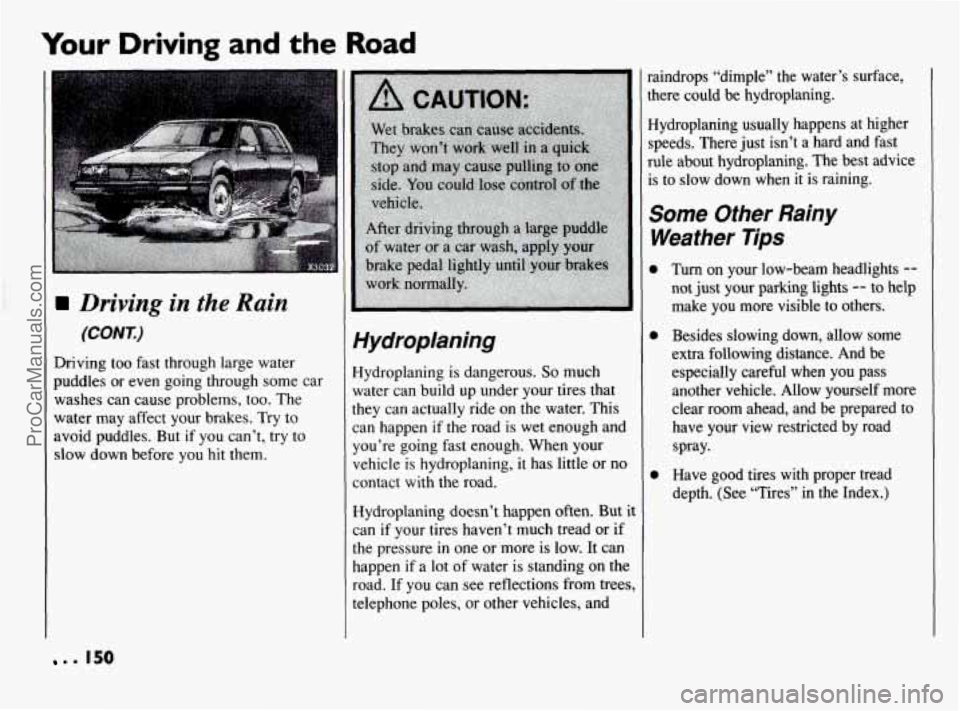
Your Driving and the Road
I
Driving in the Rain
(CONX)
Driving too fast through large water
puddles or even going through some car
washes can cause problems, too. The
water may affect your brakes.
Try to
avoid puddles. But
if you can’t, try to
slow down before you hit them.
Hydroplaning
Hydroplaning is dangerous. So much
water can build up under your tires that
they can actually ride on the water. This
can happen
if the road is wet enough and
you’re going fast enough. When your
vehicle is hydroplaning, it has little or no
contact with the road.
Hydroplaning doesn’t happen often.
But it
can if your tires haven’t much tread or if
the pressure in one or more is low.
It can
happen if a lot of water is standing on the
road. If you can see reflections from trees,
telephone poles, or other vehicles, and *aindrops “dimple” the water’s surface,
;here
could be hydroplaning.
Hydroplaning usually happens at higher
;peeds. There just isn’t a hard and fast
ule about hydroplaning. The best advice
is to slow down when it is raining.
Some Other Rainy
Weather Tips
Turn on your low-beam headlights --
not just your parking lights -- to help
make you more visible to others.
Besides slowing down, allow some
extra following distance. And be
especially careful
when you pass
another vehicle. Allow yourself more
clear room ahead, and be prepared to
have your view restricted by road
spray.
Have good tires with proper tread
depth. (See “Tires” in the Index.)
. . 150
ProCarManuals.com
Page 152 of 290
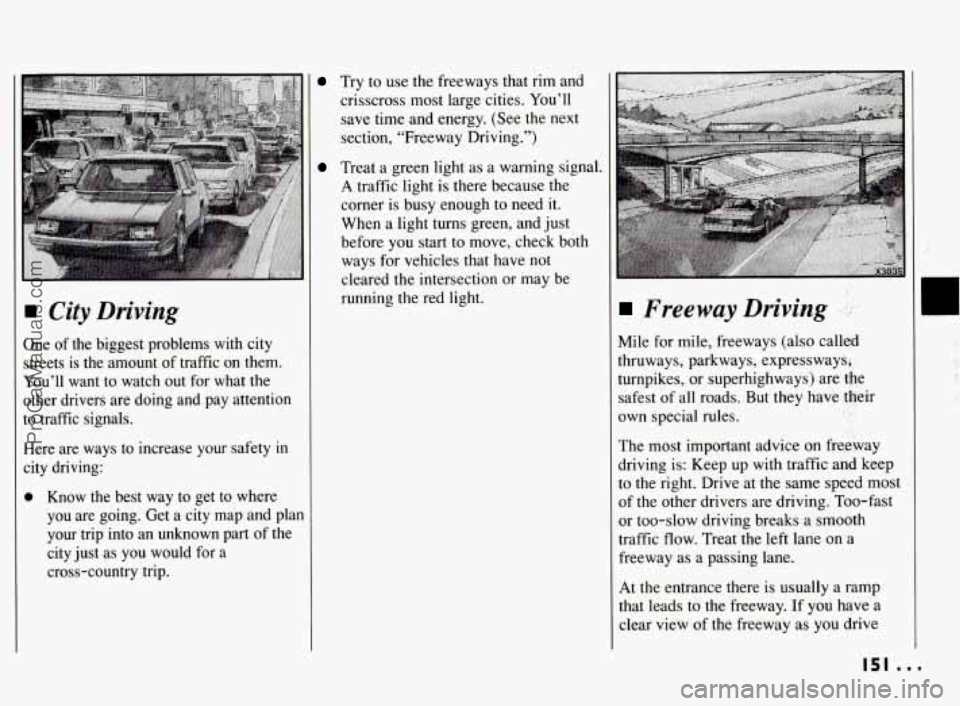
city Driving
One of the biggest problems with city
streets is the amount
of traffic on them.
You’ll want to watch out for what the
other drivers are doing and pay attention
to traffic signals.
Here are ways to increase
your safety in
city driving:
o Know the best way to get to where
you are going. Get a city map and plan
your trip into an unknown part
of the
city just
as you would for a
cross-country trip.
Try to use the freeways that rim and
crisscross most large cities. You’ll
save time and energy. (See the next
section, “Freeway Driving.”)
Treat a green light as a warning signal.
A traffic light is there because the
corner is busy enough to need it.
When a light turns green, and
just
before you start to move, check bcith
ways for vehicles that have not
cleared the intersection or may be
running the red light.
Freeway Driving ..;;.
. ./
Mile for mile, freeways (also calked
thruways, parkways, expresswaysi:.
turnpikes, or superhighways) are. @e
safest
of all roads. But they have their
own special rules. j: , ..
The most important advice on frwway
driving is: Keep up with traffic
and keep
to the right. Drive at the same speed most
of the other drivers are driving. Too-fast
or too-slow driving breaks a smooth
traffic flow. Treat the left lane 0n.a
freeway as a passing lane.
At the entrance there is usually a ramp
that leads to the freeway. If you have
a
clear view of the freeway as you drive
151 ...
ProCarManuals.com
Page 153 of 290
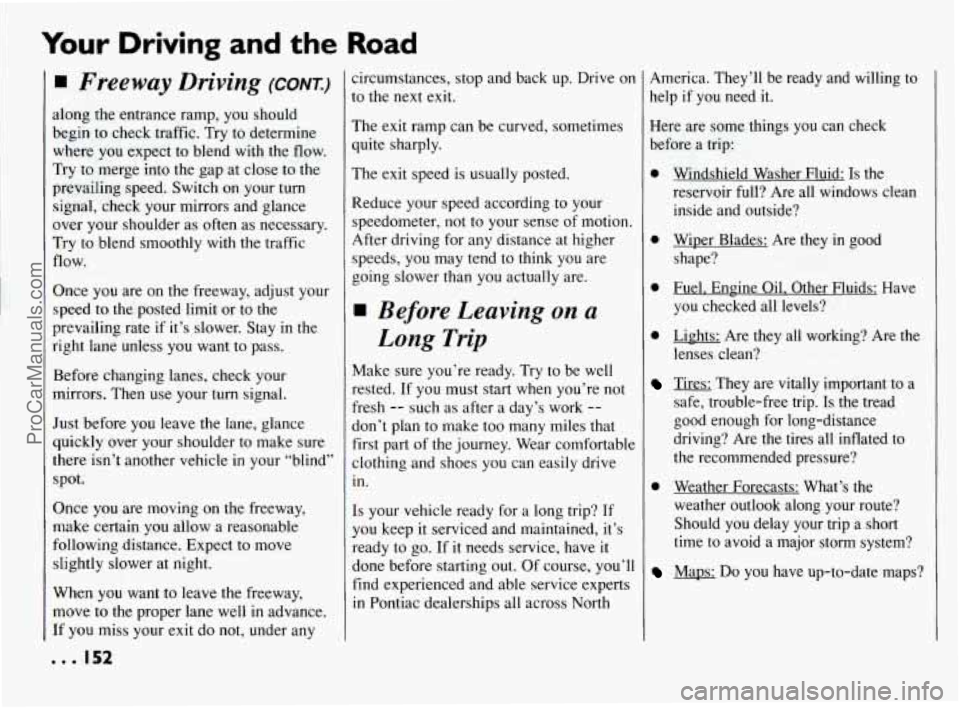
Your Driving and the Road
H Freeway Driving (CONK)
along the entrance ramp, you should
begin to check traffic. Try to determine
where you expect to blend with the flow.
Try
to merge into the gap at close to the
prevailing speed. Switch on your turn
signal, check your mirrors and glance
over your shoulder as often as necessary.
Try to blend smoothly with the traffic
flow.
Once you are
on the freeway, adjust your
speed to the.posted limit or to the
prevailing rate if it’s slower. Stay in the
right lane unless
you want to pass.
Before changing lanes, check your
mirrors. Then use your turn signal.
Just before you leave the lane, glance
quickly over your shoulder to make sure
there isn’t another vehicle in your “blind”
spot.
Once you are moving
on the freeway,
make certain you allow a reasonable
following distance. Expect to move
slightly slower at night.
When you want to leave the freeway,
move to the proper lane well
in advance.
If you miss your exit do not, under any
,.. 152
circumstances, stop and back up. Drive on
to the next exit.
The exit ramp can be curved, sometimes
quite sharply.
The exit speed
is usually posted.
Reduce your speed according to your
speedometer, not to your sense of motion.
After driving for any distance at higher
speeds, you may tend to think
you are
going slower than you actually are.
Before Leaving on a
Long Trip
Make sure you’re ready. Try to be well
rested.
If you must start when you’re not
fresh
-- such as after a day’s work --
don’t plan to make too many miles that
first part
of the journey. Wear comfortable
clothing and shoes you can easily drive
in.
Is your vehicle ready for a long trip? If
you keep it serviced and maintained, it’s
ready to go. If it needs service, have it
done before starting out. Of course, you’ll
find experienced and able service experts
in Pontiac dealerships all across North America. They’ll
be ready and willing to
help if you need it.
Here are some things
you can check
before a trip:
0 Windshield Washer Fluid: Is the
reservoir full? Are all windows clean
inside and outside?
0 Wiper Blades: Are they in good
shape?
0 Fuel. Engine Oil. Other Fluids: Have
you checked all levels?
0 Lights: Are they all working? Are the
lenses clean?
Tires: They are vitally important to a
safe, trouble-free trip.
Is the tread
good enough for long-distance
driving? Are the tires all inflated to
the recommended pressure?
0 Weather Forecasts: What’s the weather outlook along your route?
Should you delay your trip a short
time to avoid a major storm system?
Maps: Do you have up-to-date maps?
ProCarManuals.com
Page 154 of 290
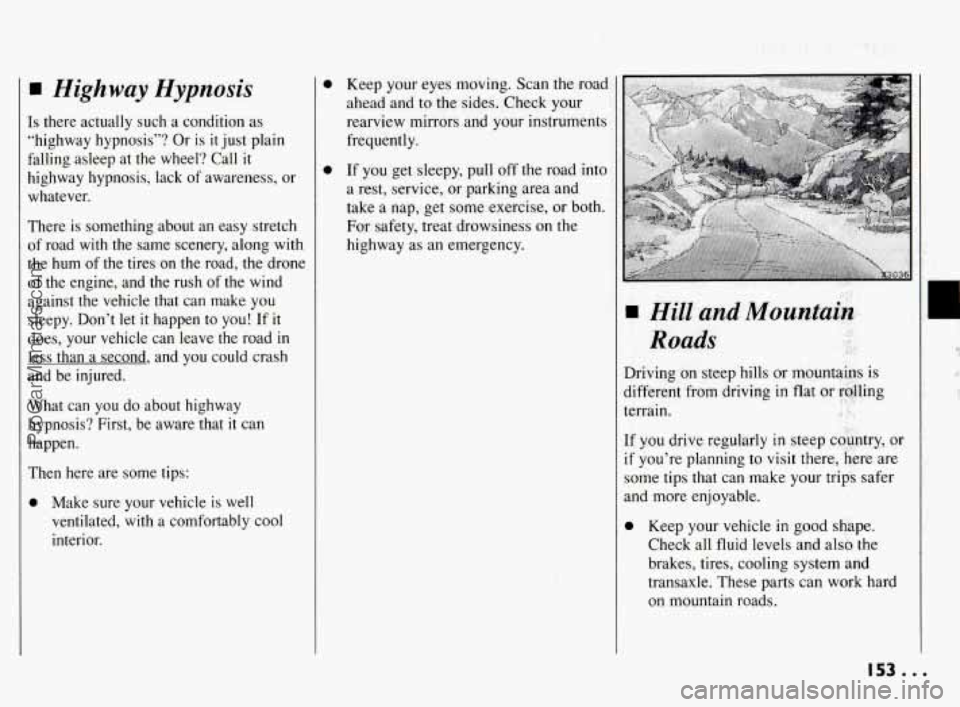
ProCarManuals.com
Page 155 of 290
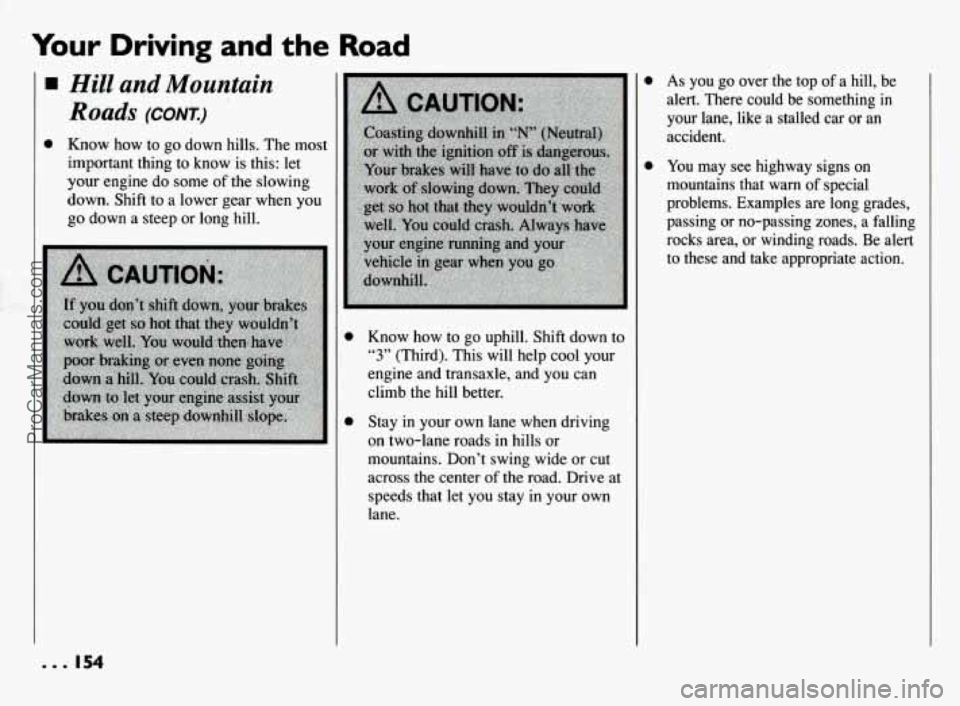
Your Driving and the Road
Hill and Mountain
Roads (CONK)
0 Know how to go down hills. The most
important thing
to know is this: let
your engine do some of the slowing
down. Shift to a lower gear when you
go down a steep or long hill.
Know how to
go uphill. Shift down to
“3” (Third). This will help cool your
engine and transaxle, and you can
climb the hill better.
Stay in your own lane when driving
on two-lane roads
in hills or
mountains. Don’t swing wide or cut
across the center of the road. Drive at
speeds that let you stay
in your own
lane.
0 As you go over the top of a hill, be
alert. There could be something
in
your lane, like a stalled car or an
accident.
0 You may see highway signs on
mountains that warn of special
problems. Examples are long grades,
passing or no-passing zones, a falling
rocks area, or winding roads. Be alert
to these and take appropriate action.
0.0 154
ProCarManuals.com
Page 156 of 290
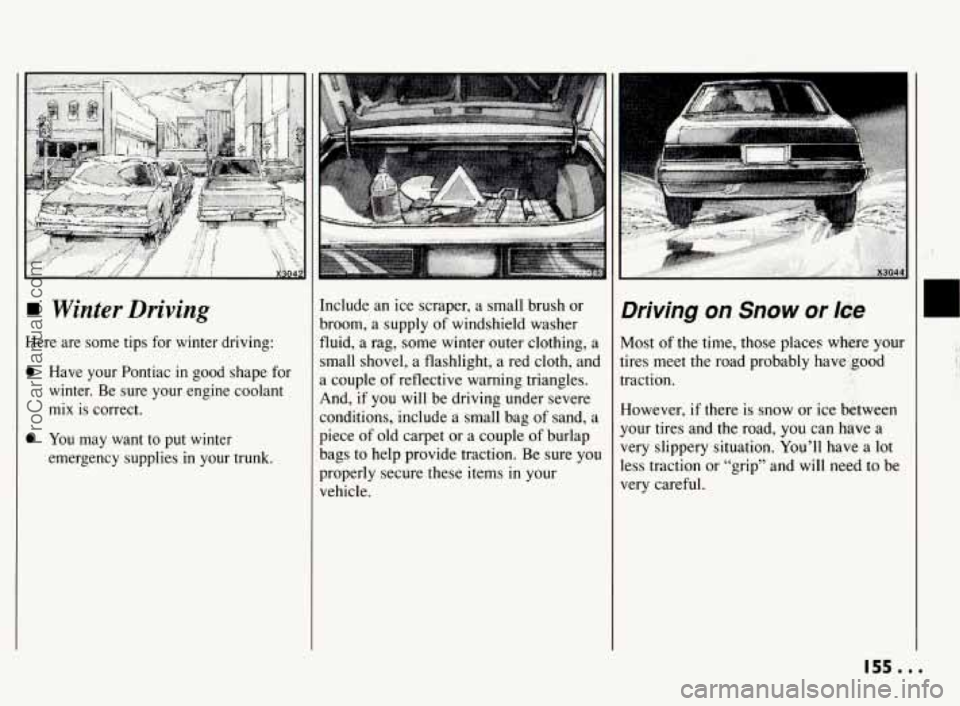
0
0
Have your Pontiac in good shape for
winter. Be sure your engine coolant
mix is correct.
You may want to put winter
emergency supplies
in your trunk. Include
an ice scraper,
a small brush or
broom, a supply of windshield washer
fluid,
a rag, some winter outer clothing, a
small shovel, a flashlight, a red cloth, and
a couple of reflective warning triangles.
And,
if you will be driving under severe
conditions, include a small bag of sand, a
piece
of old carpet or a couple of burlap
bags to help provide traction. Be sure you
properly secure these items in your
vehicle.
Driving on Snow or Ice
Most of the time, those places where your
tires meet the road probably have good
traction.
However, if there is snow or ice between
your tires and the road, you can have
a
very slippery situation. You’ll have a lot
less traction or “grip” and
will need to be
very careful.
155...
ProCarManuals.com
Page 157 of 290
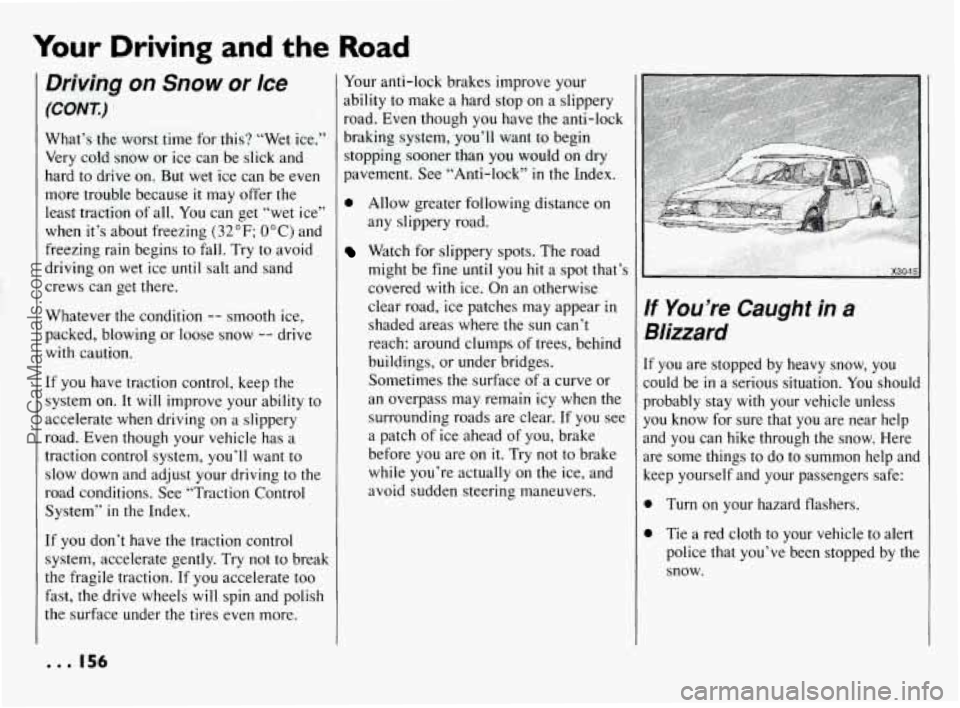
Your Driving and the Road
Driving on Snow or Ice
(CONT.)
What’s the worst time for this? “Wet ice.”
Very cold snow or
ice can be slick and
hard to drive
on. But wet ice can be even
more trouble because it may offer the
least traction of all.
You can get “wet ice”
when it’s about freezing
(32°F; OOC) and
freezing rain begins to fall. Try to avoid
driving
on wet ice until salt and sand
crews can get there.
Whatever the condition
-- smooth ice,
packed, blowing or loose snow
-- drive
with caution.
If
you have traction control, keep the
system on. It will improve your ability to
accelerate when driving
on a slippery
road. Even though your vehicle has a
traction control system,
you’ll want to
slow down and adjust your driving
to the
road conditions. See “Traction Control
System”
in the Index.
If
you don’t have the traction control
system, accelerate gently. Try not to break
the fragile traction. If
you accelerate too
fast, the drive wheels will spin and polish
the surface under the tires even more. Your
anti-lock brakes improve
your
ability to make a hard stop on a slippery
road. Even though
you have the anti-lock
braking system, you’ll want
to begin
stopping sooner than you would
on dry
pavement. See “Anti-lock”
in the Index.
0 Allow greater following distance on
any slippery road.
Watch for slippery spots. The road
might be fine until
you hit a spot that’s
covered with ice. On an otherwise
clear road, ice patches may appear in
shaded areas where the
sun can’t
reach: around clumps of trees, behind
buildings, or under bridges.
Sometimes the surface of a curve or
an overpass may remain icy when the
surrounding roads are clear. If you see
a patch of ice ahead of you, brake
before
you are on it. Try not to brake
while you’re actually on the ice, and
avoid sudden steering maneuvers.
If You’re Caught in a
Blizzard
If you are stopped by heavy snow, you
could be
in a serious situation. You should
probably stay with your vehicle unless
you know for sure that you are near help and you can hike through the snow. Here
are some things to do to summon help and
keep yourself and your passengers safe:
0
0
Turn on your hazard flashers.
Tie a red cloth to your vehicle to alert
police that you’ve been stopped by the
snow.
... 156
ProCarManuals.com
Page 158 of 290
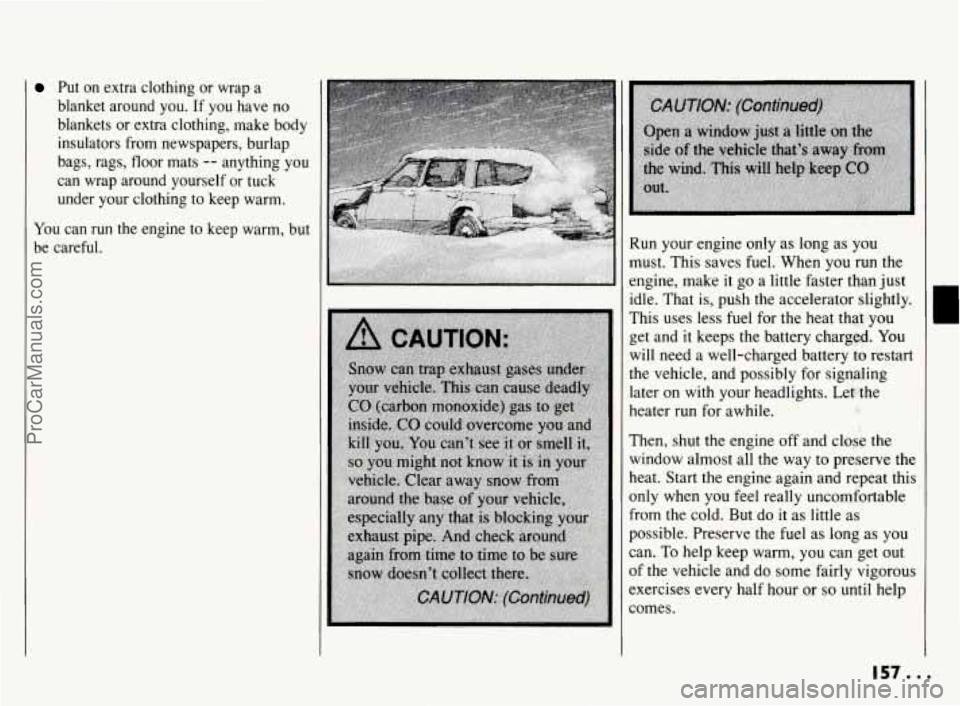
Put on extra clothing or wrap a
blanket around you. If you have no
blankets or extra clothing, make body
insulators from newspapers, burlap
bags, rags, floor mats
-- anything you
can wrap around yourself or tuck
under your clothing to keep warm.
You can
run the engine to keep warm, but
be careful. Run your
engine only as long as you
must. This saves fuel. When you run the
engine, make it go a little faster than just
idle. That is, push the accelerator slightly.
This uses less fuel for the heat that you
get and it keeps the battery charged. You
will need a well-charged battery
io restart
the vehicle, and possibly for signaling
later on with your headlights. Let, the
heater run for awhile.
Then, shut the engine off and close the
window almost all the way to preserve the
heat. Start the engine again and repeat this
only when you feel really uncomfortable
from the cold. But
do it as little as
possible. Preserve the fuel as long as you
can. To help keep warm, you can get out
of the vehicle and do some fairly vigorous
exercises every half hour or
so until help
comes.
157...
ProCarManuals.com
Page 159 of 290
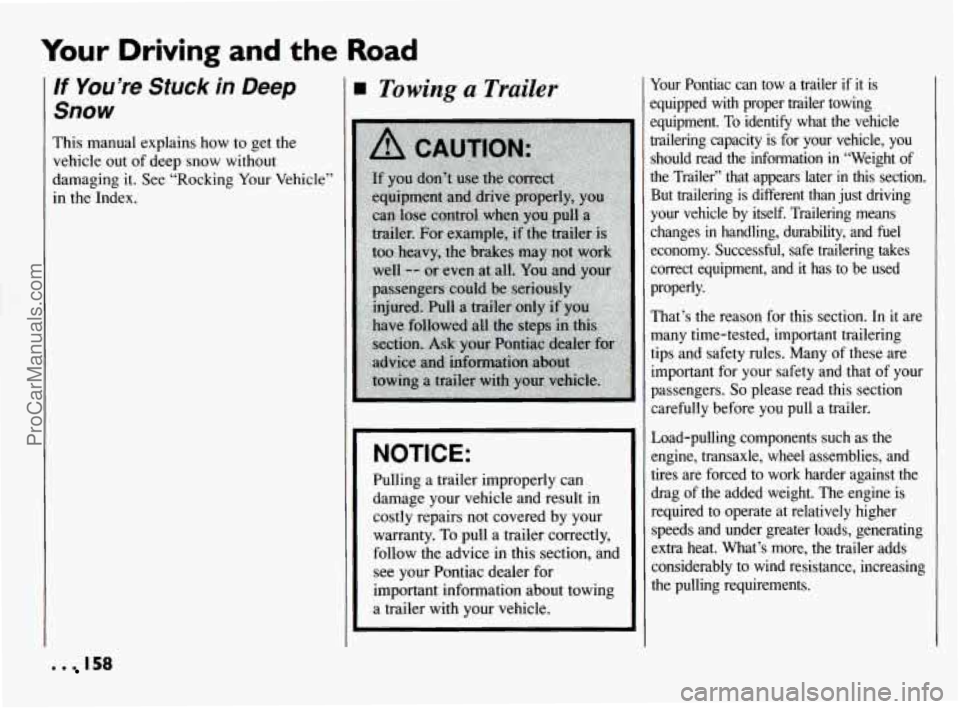
Your Driving and the Road
If You’re Stuck in Deep
Snow
This manual explains how to get the
vehicle out of deep snow without
damaging it. See “Rocking Your Vehicle”
in the Index.
Towing a Trailer
NOTICE:
Pulling a trailer improperly can
damage your vehicle and result in costly repairs not covered by your
warranty.
To pull a trailer correctly,
follow the advice in this section, and
see your Pontiac dealer for
important information about towing
a trailer with your vehicle. Your Pontiac can tow
a trailer
if it is
equipped with proper trailer towing
equipment. To identify what the vehicle
trailering capacity is for your vehicle, you
should read the information
in “Weight of
the Trailer” that appears later
in this section.
But trailering
is different than just driving
your vehicle by itself. Trailering means
changes in handling, durability, and fuel
economy. Successful, safe trailering takes
correct equipment, and it has to
be used
properly.
That’s the reason for this section. In it are
many time-tested, important trailering
tips and safety rules. Many
of these are
important for your safety and that of your
passengers.
So please read this section
carefully before you pull a trailer.
Load-pulling components such as the
engine, transaxle, wheel assemblies, and tires are forced to work harder against the
drag of the added weight. The engine is
required to operate at relatively higher
speeds and under greater loads, generating
extra heat. What’s more, the trailer adds considerably to wind resistance, increasing
the pulling requirements.
. . 158
ProCarManuals.com
Page 160 of 290
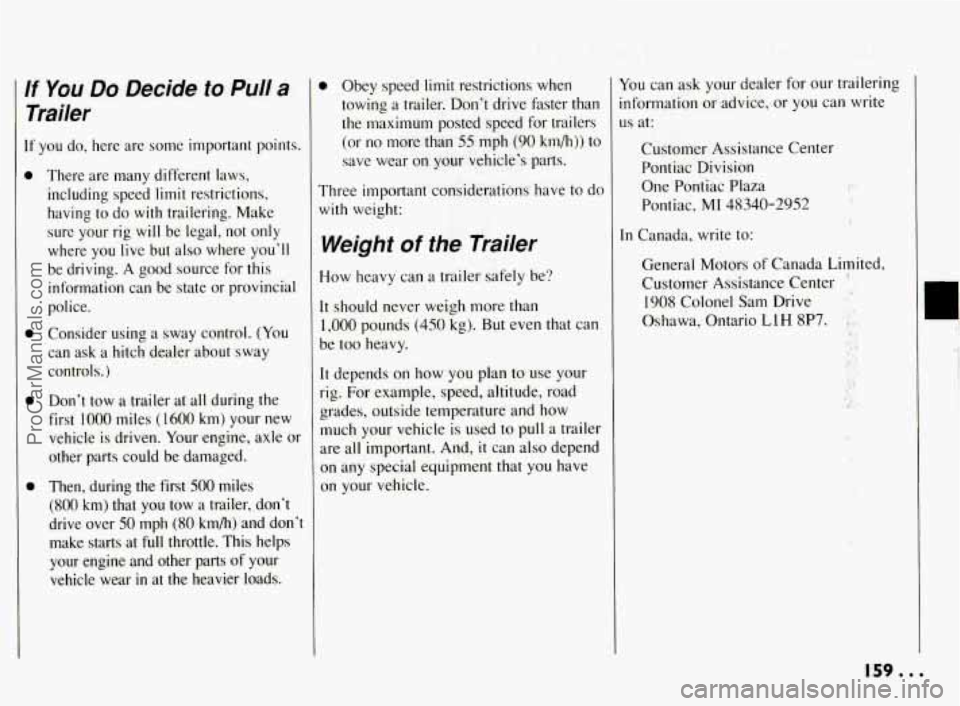
If You Do Decide to Pull a
Trailer
If you do, here are some important points.
0
0
There are many different laws,
including speed
limit restrictions,
having to do with trailering. Make
sure your rig
will be legal, not only
where you live but also where you'll
be
driving. A good source for this
information can
be state or provincial
police.
Consider using a sway control.
(You
can ask a hitch dealer about sway
controls.)
Don't tow a trailer at
all during the
first
1000 miles ( 1600 km) your new
vehicle is driven. Your engine, axle or
other parts could be damaged.
Then, during the first
500 miles
(800 km) that you tow a trailer, don't
drive over
50 mph (80 km/h) and don't
make starts at
full throttle. This helps
your engine and other parts of
your
vehicle wear in at the heavier loads.
0 Obey speed limit restrictions when
towing a trailer. Don't drive faster than
the maximum posted speed for trailers
(or no more than
55 mph (90 km/h)) to
save wear on your vehicle's parts.
Three important considerations have to do
with weight:
Weight of the Trailer
How heavy can a trailer safely be?
It should never weigh more than
1,000 pounds (450 kg). But even that can
be too heavy.
It depends on how you plan
to use your
rig. For example, speed, altitude, road
grades, outside temperature and how
much your vehicle is used to pull a trailer
are all important. And,
it can also depend
on any special equipment that you have
on your vehicle.
You can ask your dealer for our trailering
information or advice, or you can write
us at:
Customer Assistance Center
Pontiac Division
One Pontiac Plaza
Pontiac,
MI 48340-2952
In Canada, write to:
General Motors of Canada Limited,
Customer Assistance Center
1908 Colonel Sam Drive
Oshawa, Ontario
L 1 H 8P7. .:.).
':
>,
a~
l?': . '
. :*$' -.. I +. :Pm
.. ' i?',
-5%
159...
ProCarManuals.com